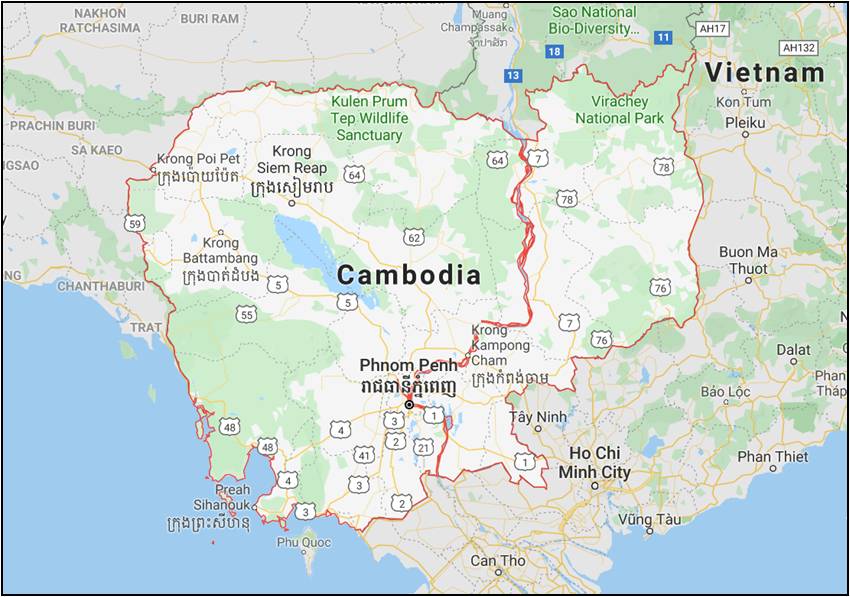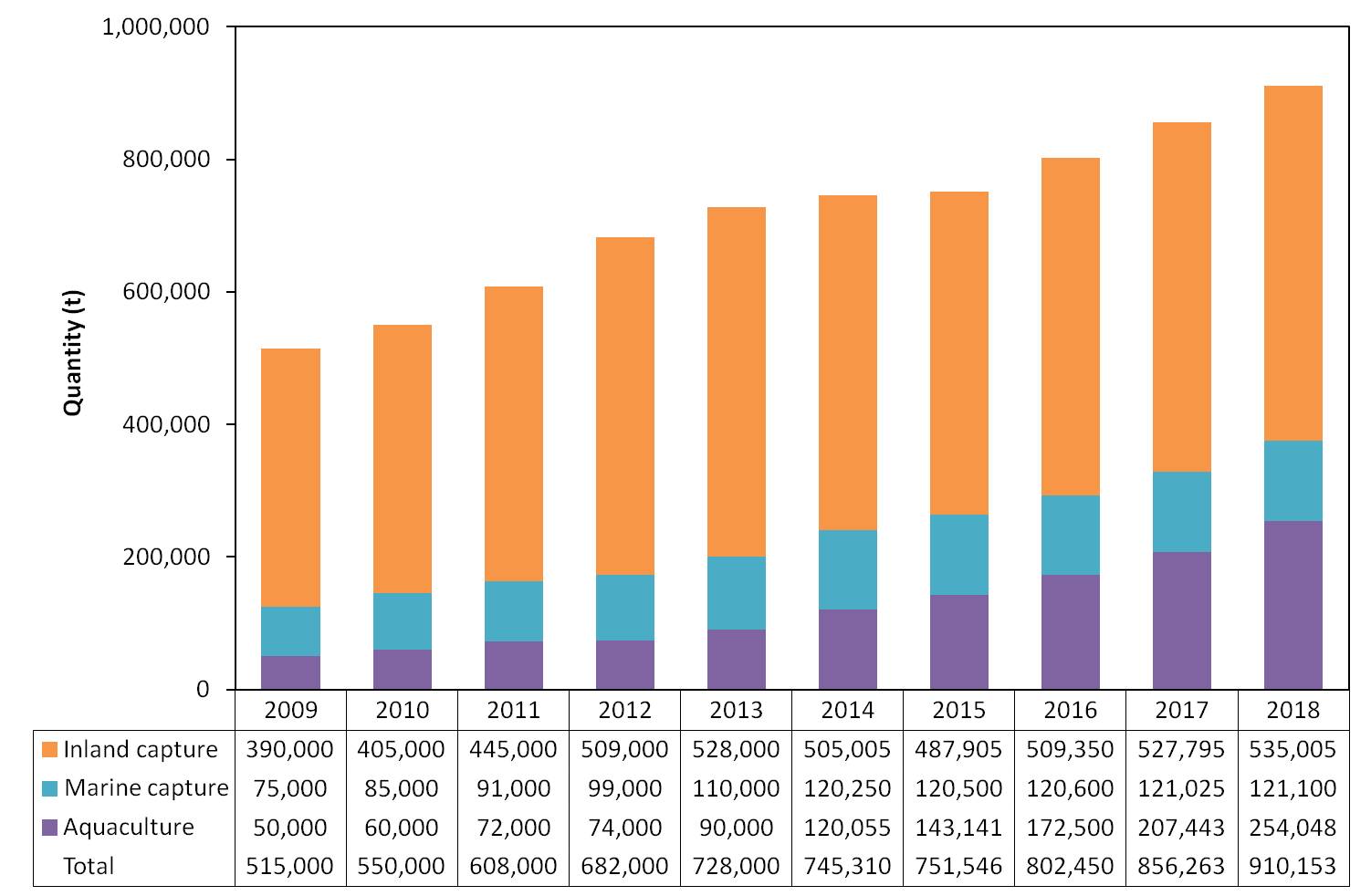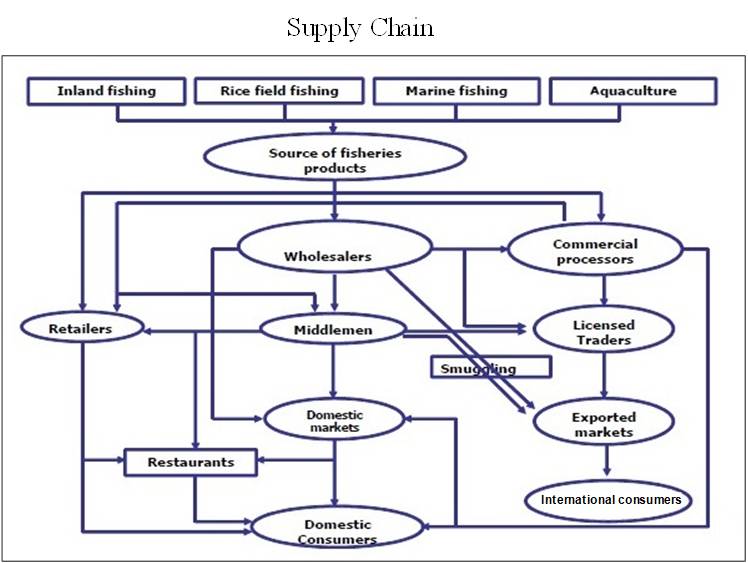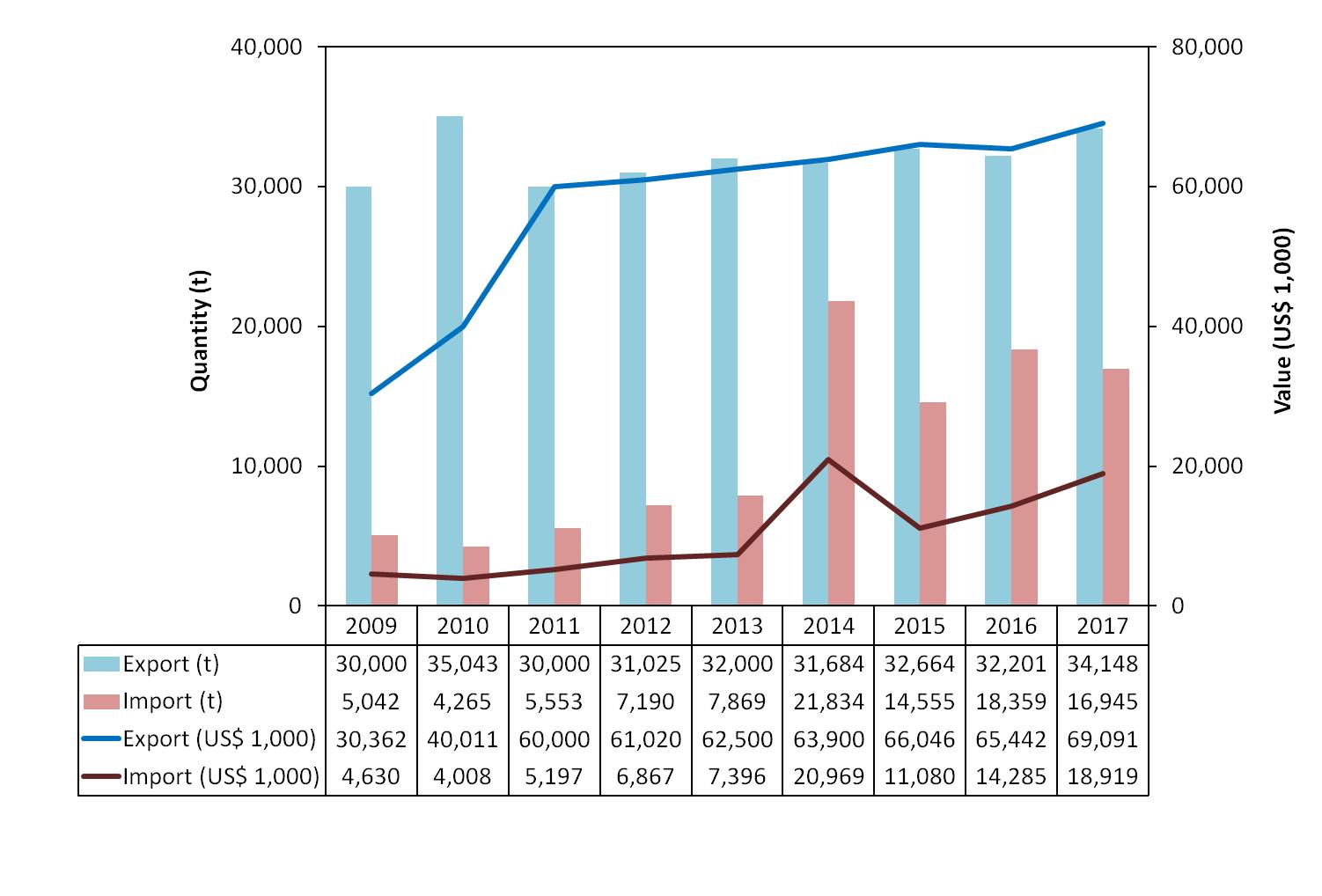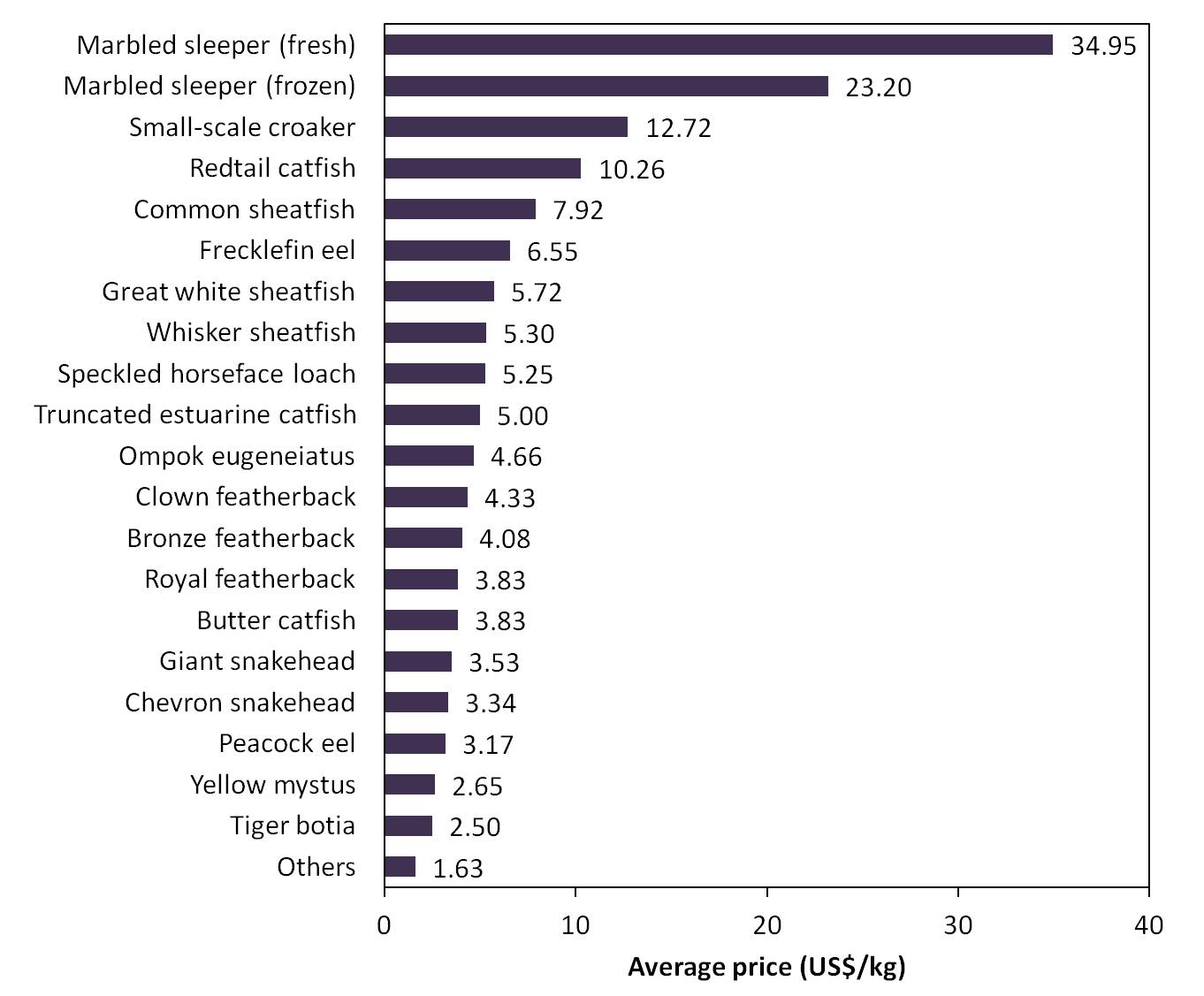By Mr. Ngin Kamsan, 2019 Regional Fisheries Policy Network (RFPN) Member for Cambodia
INTRODUCTION
The Kingdom of Cambodia covers a total land area of 181,035 km2 and shares its international borders with Lao PDR, Thailand, and Viet Nam (Figure 1). The capital city is Phnom Penh which is the center for politics, economy, and culture. The official language is Khmer, official currency is Riel, and official religion is Buddhism. In 2019, the population was 15.3 million comprised of 48.5 % male and 51.5 % female. The average size of households was 4.6 persons and the population density was 86 per km2 (NIS, 2019). Most of Cambodian people depend on agriculture for their daily livelihood. The country has a tropical monsoon climate with two seasons. The dry season starts from November to April which sends drier and cooler air with the northeast monsoon. The wet season starts from May to October, in which rainfall is derived from the southwest monsoon.
Cambodia has 69 offshore islands and the coastline extends 435 km which covers two cities and two provinces, namely: Kep City, Kampong Som City, Kampot Province and Koh Kong Province (FAO, 2019a). The exclusive economic zone (EEZ) covers 55,600 km2 of the Gulf of Thailand (FAO, 2005). The average depth of marine fishing grounds is about 50 m at the east of bank of the Gulf of Thailand (FAO, 2019a). There are about 500 inland fish species and 520 marine fish species in Cambodia (FiA, 2014).
FISHERIES SECTOR
The Fisheries Administration (FiA) of the Ministry of Agriculture, Forestry and Fisheries (MAFF) is the responsible agency for fisheries. The vision of FiA is management, conservation, and development of sustainable utilization of fisheries resources aiming at contributing to people’s food security and socio-economic development in order to enhance people’s livelihoods and the nation’s prosperity.
The fisheries sector plays a crucial role in the economy of the country. About six million people work both full time and part time in fisheries or fisheries-related activities. The value of fishery products approximately US$ 1.5 billion per year and it contributes 8-12 % to total gross domestic product (GDP). The average fish consumption is 63 kg/capita per year including inland fish (44.2 kg), marine fish (17.3 kg), and aquaculture (1.3 kg) which provides 81.5 % of animal protein intake (FiA, 2014).
Inland fisheries significantly contribute to the total fisheries production. The large floodplains, which can be found in the central part of the country around the Tonle Sap Great Lake and along the Mekong River, are important resource for inland fisheries production. Along the Mekong mainstream, 58 deep pools have been identified where there are a large number of fish species and also the habitat of river dolphin (FAO, 2019a). The inland fishing gears are gill nets, cast nets, trap, baskets, hooked long lines, seine nets, trawls, lift nets, barrage trap, among others.
On the other hand, marine fisheries have been developing slowly compared to inland fisheries. Cambodia’s marine fishery domain is divided into: 1) inshore fishing area, which extends from the coastline at higher high tide to the 20-meter-deep line, and 2) offshore fishing area, which extends from the 20-meter-deep line to the outer limits of the EEZ. The number of marine fishing boats has increased in recent years. The common fishing gears used in marine waters are mackerel purse seines, anchovy purse seines, crab gillnets, shrimp gillnets, crab traps, hook line, squid trap, and so on.
Moreover, aquaculture is considered to have great potential for increasing fisheries production in the country. Aquaculture systems include cage culture, pond culture, and rice field culture. Cage culture is practiced mainly in floating villages along the Tonle Sap Great Lake and Mekong River, Tonle Sap River, and Bassac River. Pond and rice field culture are practiced by many farmers for household consumption and additional income generation. The marine species that are cultured are shrimp, seabass, grouper, snapper, seaweed, and so on. Catfish Pangasius and giant snakehead Chana micropeltes are the major species in terms of production from aquaculture (FAO, 2011).
The total fish production has increased from 515,000 t in 2009 to 910,153 t in 2018. During the last 10 years, the inland fish production was higher than marine fish production while aquaculture production was continually increasing. In 2018, the total fish production was reported to be 910,153 t and the largest proportion came from inland capture fisheries accounting for approximately 59 %, followed by aquaculture at about 28 %, and marine capture fisheries at 13 % (Figure 2).
FISHERIES SUPPLY CHAIN
The supply chain of fish and fishery products from inland fishing, rice field fishing, marine fishing, and aquaculture is illustrated in Figure 3. The majority of fish and fishery products in Cambodia is consumed domestically or marketed at low value international markets. The country has an old tradition of processing freshwater fish such as fish paste, fermented fish, dry salted fish, smoked fish, fish sauce, and dried fish for animal feed. The two freshwater fish species, namely: Cirrhinus siamensis and C. lobatus, are important for processing for the domestic market. For marine fishes, the main commercial species are mackerels, scads, anchovies, snappers, shrimps, blue swimming crab, cuttlefish, squid, green mussels, oysters and blood cockles (FAO, 2019a).
EXPORT AND IMPORT OF FISH AND FISHERY PRODUCTS
The total quantity of exported fish and fisheries products of Cambodia have increased from around 30,000 t (US$ 30.3 million) in 2009 to around 34,148 t (US$ 69.1 million) in 2017 (Figure 4). The average price of important freshwater fish species exported by Cambodia in 2004 is shown in Figure 5. The main export markets are Thailand and Viet Nam followed by Singapore, Malaysia, China, Hong Kong, Taiwan, Japan, USA, and Australia (FAO, 2019a).
For import, the total quantity increased from about 5,042 t (US$ 4.6 million) in 2009 to about 16,945 t (US$ 18.9 million) in 2017 (Figure 4), which came from Viet Nam, Thailand, China, Japan, Canada, Germany, USA, Singapore, Indonesia and Ecuador (UN Comtrade, 2019).
In 2017, Cambodia exported about 33,957 t of fish and about 191 t of crustaceans with the approximate value of US$ 68.5 million and US$ 0.6 million, respectively (Figure 6). Moreover, the country imported around 8,859 t (US$ 12.8 million) of fish, 144 t (US$ 1.2 million) of crustaceans, 109 t (US$ 0.5 million) of mollusks, and 7,833t (US$ 4.5 million) of other fishery products.
The inland fish and fishery products of Cambodia are exported in three different ways. First, chilled fish are exported via land using trucks or cars. Second, live freshwater species are exported using cages big boats via water-ways. Third, high-value live fish and some fish products are exported via air (FAO, 2011). Figure 7 shows the export routes of inland fishery products by land and boat to neighboring countries. The most important landing sites for freshwater fish are Chong Khneas and Kampong Khleang in Siem Reap and Kampong Chhnang Province for export to Thailand via Poipet and Viet Nam via Phnom Penh, and Kratie for export to Lao PDR (and then to Thailand) via Stung Treng. Fresh and live fish were exported using the international airport in Phnom Penh while frozen products were exported through Sihanoukville seaport (FAO, 2019a). For marine fishes, there are a total of 131 landing sites including 69 in Sihanoukville, 55 in Koh Kong, four in Kampot, three in Kep. However, harbor facilities and services are limited and poor because most of the ports are small and located in rural areas (Puthy, 2007).
LAWS AND REGULATIONS RELATED TO FISHERIES TRADE
The following are the articles related to the transport and trade of fish and fishery products under Chapter 12 of the Fisheries Law of Cambodia in 2006:
Article 64. Commercial transportation of fishery products in the Kingdom of Cambodia shall need a license and be under the inspection of Fisheries Administration. Procedures of transporting fishery products as stipulated in paragraph 1 of this article of this law shall be determined by the proclamation of the MAFF.
Article 65. A physical or legal person who transports fishery products shall pay premium on fishery products to the FiA, except for family use and research purposes. The rate of premium on fishery products shall be determined by the proclamation of the MAFF and the Ministry of Economy and Finance (MEF). The specification of fishery products shall be determined by the proclamation of the MAFF.
Article 66. Commercial export of fishery products can be taken place, when:
- A license has been issued by the head of the central FiA.
- A license has been issued by the CITES Management Authority of Cambodia for endangered fishery products although it is not for commercial purposes.
- A quality control certificate in fishery pathology has been issued depending on the demand of importing country.
Article 67. Commercial import of fishery products can be taken place, when:
- A license has been issued by the head of the central FiA.
- A license has been issued by the CITES Management Authority of exporting country for endangered fishery products although it is not for commercial purposes.
- A quality control certificate in fishery pathology has been issued by the exporting country.
Article 68. Exporting, importing, buying, selling, transporting, processing and stocking of endangered fishery products shall only be authorized for products from aquaculture and/or in compliance with article 64, 65, 66 and 67 of the law on fisheries and CITES Convention. The endangered fishery products shall be determined by a sub-decree.
Article 69. The following shall be prohibited:
- Buying, selling processing stocking and transporting of fishery products from illegal fishing or using illegal fishing gears.
- Commercial transportation of fishery products without license; or contradicting the license such as specification of fisheries products, quantity, validity, direction and/or by-pass, and transportation means.
- Transportation of illegal fishing gears in fishery management area.
Transportation of fishery products in the closed season that have no stocking license or have not deducted from stocked quantities.
INTERNATIONAL TRADE AGREEMENTS
Cambodia is a member and signatory of the following international trade agreements:
- Convention on Fishing and Conservation of Living Resources of the High Seas in 1960
- International Convention for the Regulation of Whaling since 2006
- United Nations Convention on the Law of the Sea (UNCLOS) in 1983 (signed but not yet ratified)
- Convention on International Trade in Endangered Species of Wild Fauna and Flora (CITES) in 1997
- Association of Southeast Asian Nations (ASEAN) in 1999
- ASEAN Free Trade Area (AFTA) in 1999
- World Trade Organization (WTO) in 2004
- Memorandum of Understanding (MoU) related to fisheries with Viet Nam in 2011
- MoU related to fisheries with Thailand in 2019
- Port State Measures Agreement (PSMA) (under process)
- United Nations Fish Stock Agreement (UNFSA) (under process)
ISSUES ON FISHERIES TRADE
The fisheries trade of Cambodia is facing the following issues:
- Limited technical knowledge of producing commercially-important aquaculture species, particularly on addressing aquatic animal disease, resulting to low aquaculture production
- High cost of electricity for aquaculture intensification and fish processing facilities that generate low profit for fishers and fish processors
- Lack of control on the export and import of fishery products because of weak cross-border collaboration among key players in the country
- Sanitary and phytosanitary measures are not well integrated to production chains
- Laboratory testing and certification systems required by international markets are not well established
- Inadequate incentives for the private sector to enter commercial post-harvest activities
- Limited funds and equipment to support the management, research and extension activities, and conservation and protection of fishery resources
- Limited market opportunities because production and market systems of the country are not yet established well
- Illegal, unreported, and unregulated (IUU) fishing still remain that leads to destroyed marine fishery resources, and several international markets prohibit importation of fish and fishery products from IUU fishing
WAYS FORWARD
Through the efforts of the FiA, the fisheries sector of Cambodia is supported to diversify the export market for fish and fishery products. FiA would work together with other government agencies for efficient monitoring system of fisheries trade, particularly exportation and importation. The environmental guidelines developed for fish processors and exporters will be implemented in order ensure that SPS standards are observed to improve competitiveness of exported fishery products. Fisheries inspection service would be established to enhance the safety and quality of traded fish and fishery products to meet the international standards.
For aquaculture, technical knowledge, especially disease issues would be developed in order to increase the production. For marine fisheries, the priority actions of the FiA include: 1) implementing international instruments such as PSMA and UNFSA; 2) revising the Fishery Law; and 3) developing the National Plan of Action to Prevent, Deter, and Eliminate Illegal, Unreported, and Unregulated Marine Fishing (NPOA IUU) and National Plan of Control and Inspection (NPCI) in order to ensure sustainable fisheries and that fish and fishery products from Cambodia could be traded internationally.
Moreover, the FiA would collaborate with the private sector and development partners in order to ensure compliance with the ASEAN Sectoral Integration Protocol for Fisheries. Cross-border collaboration among key players will be improved. Negotiations are being carried out for exemption from value-added tax on all exported fishery products.
REFERENCES
FAO. (2005). The Kingdom of Cambodia General Economic Data-May 2005. Retrieved from http://www.fao.org/fi/oldsite/FCP/en/KHM/profile.htm
FAO. (2011). Fishery value chain analysis in Cambodia. Retrieved from http://webcache.googleusercontent.com/search?q=cache:9weC7y1xlvAJ:www.fao.org/fileadmin/user_upload/fisheries/docs/Cambodia_edited.doc+&cd=1&hl=en&ct=clnk&gl=th
FAO. (2019a). Fishery and Aquaculture Country Profiles. The Kingdom of Cambodia. Retrieved from http://www.fao.org/fishery/facp/KHM/en
FAO. (2019b). Fishery Commodities Global Production and Trade (online query). Fishery and Aquaculture Department. Retrieved from http://www.fao.org/fishery/statistics/global-commodities-production/query/en
FiA. (2014). Cambodian Fisheries at a Glance. Fisheries Administration of Cambodia. Phnom Penh.
FiA. (2017). Assessment of the Fisheries Sector Value Chain. Department of Fisheries Post-harvest Technologies and Quality Control. Fisheries Administration of Cambodia. Phnom Penh.
FiA. (2018). Annual report in 2018 and way forward to 2019. Fisheries Administration of Cambodia. Phnom Penh.
NIS. (2019). General Population Census of the Kingdom of Cambodia 2019. National Institute of Statistics. Ministry of Planning. Kingdom of Cambodia. Retrieved from http://www.nis.gov.kh/nis/Census2019/Provisional%20Population%20Census%202019_English_FINAL.pdf
Puthy, E. (2007). Marine Fisheries Resources Management Potential for Mackerel Fisheries of Cambodia. Retrieved from http://webcache.googleusercontent.com/search?q=cache:Sh5Sl2YSI9oJ:www.unuftp.is/static/fellows/document/puthy07prf.pdf+&cd=1&hl=en&ct=clnk&gl=th
Rab, M. A., Hap, N., Seng, L., Ahmed, M., Viner. K. (2006). Marketing infrastructure, distribution channels and trade pattern of inland fisheries resources in Cambodia: an exploratory study. The WorldFish Center. Batu Maung, Penang, Malaysia.
UN Comtrade. (2019). UN Comtrade Analytics. UN Comtrade Database. Retrieved from https://comtrade.un.org/labs/data-explorer/
ACKNOWLEDGMENTS
The author would like to express gratitude to the Director General of Fisheries Administration H.E. Eng Cheasan, Deputy Director of FiA Mr. Bouy Roitana, and Cambodian National Coordinator Dr. Em Puthy, for the nomination and support as the 2019 RFPN Member for Cambodia. Also, he would like to thank SEAFDEC officials and staff for their technical guidance to improve this report. The other 2019 RFPN members are also appreciated for their help and sharing their knowledge. The Japanese Trust Fund is appreciated for the funding support to the RFPN program.
ABOUT THE AUTHOR
Mr. Ngin Kamsan is the Vice Chief of the Crocodile Conservation and Industry Development Division of the Fisheries Administration (FiA), Ministry of Agriculture, Forestry and Fisheries (MAFF) in #186, Preah Norodom Blvd, Sangkat Tonle Bassac, Khan Chamcar Mon, Phnom Penh, Cambodia, P.O. Box 582. He can be reached at +855 92 555 446 and nginkamsan@gmail.com.
SUPPLEMENTARY DATA
Cambodia Supplementary Data (click to download)
 SEAFDEC Southeast Asian Fisheries Development Center
SEAFDEC Southeast Asian Fisheries Development Center
